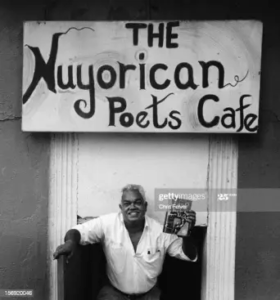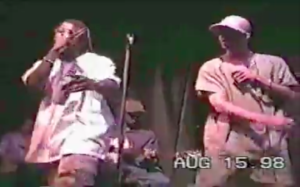 Located in Alphabet City, NYC, the Nuyorican Poets Cafe became a place where lyricists went to cultivate their craft. It has now been around for almost 50 years, cementing itself in NYC history, popularized through its award-winning poetry and poetry slams, theatre, and music. Numerous celebrities have either attended or performed at the Cafe, from Laurence Fishburne to Russell Simmons to Natalie Portman. Originally a place for Puerto Rican artists to speak their truth, how did the Cafe’s roster, audience, and space expand to become an incubator for revered talents such as Mos Def, MF DOOM, Erykah Badu, and more?
Located in Alphabet City, NYC, the Nuyorican Poets Cafe became a place where lyricists went to cultivate their craft. It has now been around for almost 50 years, cementing itself in NYC history, popularized through its award-winning poetry and poetry slams, theatre, and music. Numerous celebrities have either attended or performed at the Cafe, from Laurence Fishburne to Russell Simmons to Natalie Portman. Originally a place for Puerto Rican artists to speak their truth, how did the Cafe’s roster, audience, and space expand to become an incubator for revered talents such as Mos Def, MF DOOM, Erykah Badu, and more?
Sprouting from the Nuyorican cultural and intellectual movement, the cultural hub was initially founded for underrepresented Puerto Rican poets, playwrights, and musicians. Co-founded by poet and writer Miguel Algarín in 1975, the legendary cafe started out as a weekly salon he held in his living room. A place to create, perform, and commune, the spoken elements were a central trait of Nuyorican poetry. But, within just two years, Algarín’s gatherings outgrew his living room. So, the Cafe was born.


The term “Nuyorican” means “New York Puerto Rican.” It was initially a pejorative term used to categorize displaced island natives, and subsequent generations, during the Great Migration of the 50s and 60s. The Lower East Side then became one of the Puerto Rican enclaves. The Nuyorican movement became a way for Puerto Ricans to represent their struggles while showcasing pride in their identities through rich artistic outputs, transforming what it meant to be rep Nuyorican in the process. The Cafe helped solidify the movement by providing a community-oriented space for the performance elements. Before social media, being a part of a community was how artists learned to sharpen their chops.

In the 90s, when gangsta rap was becoming increasingly popular, all the wordplay rappers were being cast into the “underground” category. So, all the lyricists naturally started to show up at poetry readings. The Cafe was closed for most of the 80s due to crack, AIDS, and gentrification. In preparation for its reopening, Holman, co-director at the time, reinvigorated NYC’s poetry scene by bringing the brasher slam poetry format. This is what eventually drew in large crowds and the press, bringing in a fresh generation of poets who had grown up with Hip Hop culture. In opposite parallel to the commercial Hip Hop scene, the black and Latinx poets echoed the Native Tongues movement. The Cafe’s relationship with Hip Hop became cemented after a night called All That, hosted by Bobbito Garcia, allowed aspiring MCs to perform one verse with a DJ and a live band.


MF DOOM had his first performance as the DOOM persona at the Cafe, marking his return to Hip Hop. Eminem also appeared in ‘98, performing off a cassette backing track a month before he signed with Dr. Dre. Even Erykah Badu came through, performing her debut song, “On & On.” The cool and underground place to be, the Cafe was a central node in terms of making connections and becoming inspired. With many formative underground Hip Hop artists coming out of this poetry scene from Mos Def, Talib Kweli, Common, Saul Williams, and El-P, the community outgrew its physical space yet again. Prompting a DIY scene outside the Cafe, ciphers generated that went on until three in the morning. From Epic Records A&Rs to Fondle ‘Em record label signings to appearances from Wu-Tang Clan affiliate Killah Priest, popping up at the Cafe was a gate-keeper-free way to network, get noticed, and perfect one’s craft.

